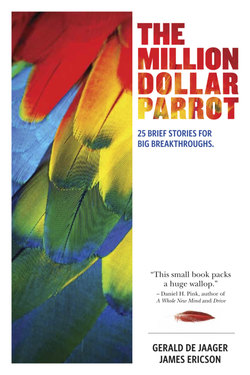Читать книгу The Million Dollar Parrot: 25 Brief Stories for Big Breakthroughs - Gerald de Jaager - Страница 8
На сайте Литреса книга снята с продажи.
ОглавлениеThe Homunculus
Sensing things wrongly is built into us.
Bob Toski is one of golf’s great teachers, author of five instruction books on that subject. He once told an interviewer that the secret of his teaching success lay in understanding the homunculus:
A natural swing produces a slice. That's because the homunculus, the part of the brain that controls motor movement, sees the hands as the largest part of your anatomy. . . . [W]hen the day comes to play golf, the instinct to move your hands away from you really takes over. On the downswing the hands move away from the body too soon, out toward the target line, and you end up cutting across the ball from out to in. Thanks to the homunculus, I make a very good living.38
The homunculus isn’t an actual part of your brain, but rather a depiction of what you look like to your brain based on how much of your brain’s capacity is devoted to each part of your body. The image at the beginning of this lens illustrates the homunculus. Your hands, lips, and face are much better represented in your brain than most of the rest of your body. More brain cells are devoted to one thumb, for example, than to the entire back.39 (In mice, the whiskers and snout take up most of the sensory brain space, whereas monkey brains dedicate large areas to the feet. That’s evolution for you.)
Much as the ability to execute a good golf swing is impaired by the brain’s over-recognition of the hands and under-recognition of the trunk and legs, imbalanced inputs to the corporate “brain” get in the way of organizational performance.
If you drew a picture of your organization based on the inputs it seeks and deals with and the ones that have a hard time getting recognized and addressed, what would that picture look like? Would it look that way because it’s proper, or just because of evolution? Consultant Roger Martin argues, “The most exasperating fact about big companies in crisis is that they got there by doing what once made them big.”40
Harvard Business School professor Robert Simons has similarly observed that what has been said of armies may also apply to companies: they are often very ready to fight the last war, but unprepared for the next one. In articles and books, Simons has shown how often control systems fail to capture all the current data that decision makers ought to have, because those systems are designed for yesterday, not today. For example, systems and practices established to take advantage of boom times can hamper adaptation to downturns.41
Speaking at The Masters Forum in 2007, information technology expert Jeffrey Sampler urged that organizations have to develop new sensory skills to compete effectively in an environment of rapid change and competitive threats that can appear seemingly out of nowhere. “How many people have a mental model that’s incorrect? You think you understand the way the world works, based on your working data, and you make decisions based on that data, but the data may be totally inaccurate,” he said.42 Among other things, he asked:
Do you have real-time customer profitability data down to the second decimal place?
Do you have accurate, granular cost data that capture not only direct cost but indirect cost? You’ll have to make some fairly precise cuts, and you must know that.
If an organization is not as sensitively attuned to those data as we are to our lips or fingertips, Sampler was saying, it will be in trouble.
You might add issues of your own to the ones Sampler noted. In a major survey, only 23 percent of companies said they had a systematic way of identifying what knowledge needed to be protected and retained for the company to remain fully competitive.43 Two major 2007 studies of boards of directors reported that directors felt that they lacked adequate knowledge of vital strategic and operational information regarding the overall health of the organization.44
In the first lines of his book, Evolution of Consciousness, Stan-ford professor Robert Ornstein writes, “The mind is a squadron of simpletons. It is not unified, it is not rational, it is not well design-ed—or designed at all. It just happened, an accumulation of innovations of the organisms that lived before us.”45 Organizations can be like that, too, unless those in charge remember the homunculus.
Get it right, and an organization can develop the same sensing ability as Erik Weihenmayer, the first blind climber to scale Mount Everest: “His hands are like antennae, gathering information as they flick outward, surveying the rock for cracks, grooves, bowls, nubbins, knobs, edges and ledges, converting all of it into a roadmap etched into his mind.”46
Experience the Homunculus
from “They Do It with Mirrors” by Helen Phillips47
There are a few simple illusions that demonstrate the amazing malleability of the brain’s image of the body. One trick is to sit at a table and recruit a helper. Hide one hand under the table, resting palm down on your knee. Then ask your helper to tap, touch and stroke with their fingertips the back of your hidden hand and the table top directly above the hand with an identical pattern of movements, for a minute or two.
It’s important that you concentrate on the table, where your helper is touching, and that you can’t see your hand or their hand under the table. The more irregular the pattern, and the more synchronized the touches you can see and feel, the more likely you are to feel something very strange. About half the people who try this find that the table starts to feel like part of their body—as though the hand is transferred into the table.
